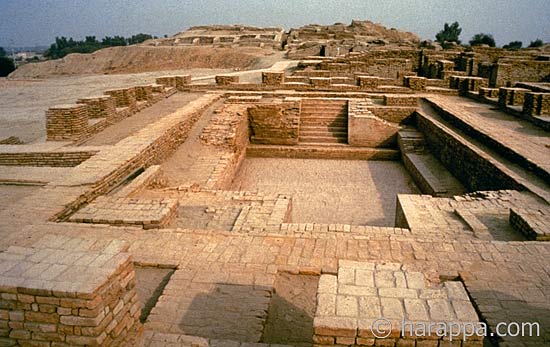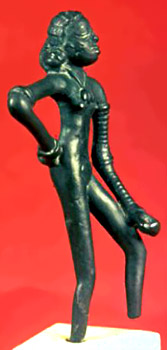Difference between revisions of "Mohenjo Daro"
| Line 21: | Line 21: | ||
Different types of ornaments and headdresses found at Mohenjo Daro revealed that different classes were already existent. Carved stone seals having animal motifs and writing, and precious metal ornaments distinguished the elites from the commoners of Mohenjo Daro. The picture below contains the metal bracelets and bands from Mohenjo Daro. | Different types of ornaments and headdresses found at Mohenjo Daro revealed that different classes were already existent. Carved stone seals having animal motifs and writing, and precious metal ornaments distinguished the elites from the commoners of Mohenjo Daro. The picture below contains the metal bracelets and bands from Mohenjo Daro. | ||
| + | http://www.harappa.com/indus2/gif/65.jpg | ||
== Military == | == Military == | ||
Perhaps the most surprising material marker of Mohenjo Daro is its military. It was nonexistent! No evidence of for an organized military force was excavated, and no depictions of warfare were present in the Mohenjo Daro artifts. Finally, the city of Mohenjo Daro had no walls, suggesting that like the Minoans, they were not ever attacked by outsiders | Perhaps the most surprising material marker of Mohenjo Daro is its military. It was nonexistent! No evidence of for an organized military force was excavated, and no depictions of warfare were present in the Mohenjo Daro artifts. Finally, the city of Mohenjo Daro had no walls, suggesting that like the Minoans, they were not ever attacked by outsiders | ||
| − | |||
== Sources and Outside Links For More Information == | == Sources and Outside Links For More Information == | ||
Revision as of 12:40, 25 March 2012
Contents
Material Markers of Mohenjo Daro
As we learned previously, the common material markers of society are cities, bronze technology, writing, great ceremonial buildings, temples, monumental art, hierarchies and class divisions, and some form of law held together with an organized military. The material markers of Mohenjo Daro include great buildings and temples (however no stone sculptures), symbolic art, bronze technology, their Indus writing and social classes.
Buildings and Temples
Excavations at Mohenjo Daro revealed the "Great Bath", a massive columned building and water tank pictured below.This is the first public water system in history. In addition archeologists uncovered a mysterious building with brick foundation and sockets for a wooden super structure and even multiple doorways inside. This building is a mystery to archeologists because its use has not been determined, yet its sheer size suggests importance. For more information on the Bath and other buildings, see http://www.harappa.com/indus/8.html

Art and Bronze work
While no monumental art was created by the inhabitants of Mohenjo Daro, small art pieces and sculptures were found. Two prime examples are the dancing girl of Mohenjo Daro (pictured below), and the sculpture of a high priest. The dancing girl shaped out of bronze proves that the inhabitants of Mohenjo Daro were highly skilled bronze workers.

Social Classes
Different types of ornaments and headdresses found at Mohenjo Daro revealed that different classes were already existent. Carved stone seals having animal motifs and writing, and precious metal ornaments distinguished the elites from the commoners of Mohenjo Daro. The picture below contains the metal bracelets and bands from Mohenjo Daro.

Military
Perhaps the most surprising material marker of Mohenjo Daro is its military. It was nonexistent! No evidence of for an organized military force was excavated, and no depictions of warfare were present in the Mohenjo Daro artifts. Finally, the city of Mohenjo Daro had no walls, suggesting that like the Minoans, they were not ever attacked by outsiders
Sources and Outside Links For More Information
http://www.indianetzone.com/photos_gallery
http://www.mohenjodaro.net/ for pictures
http://www.ancient-wisdom.co.uk/Pakistanmohenjo.htm
Beniretto, Rosie, and Clay Elliot. "India, Hinduism, and Buddhism." Manual for Cultural Foundations of Ancient Civilizations. Houston: St. John's School, 2011-2012. 99-100. Print.
Dlu